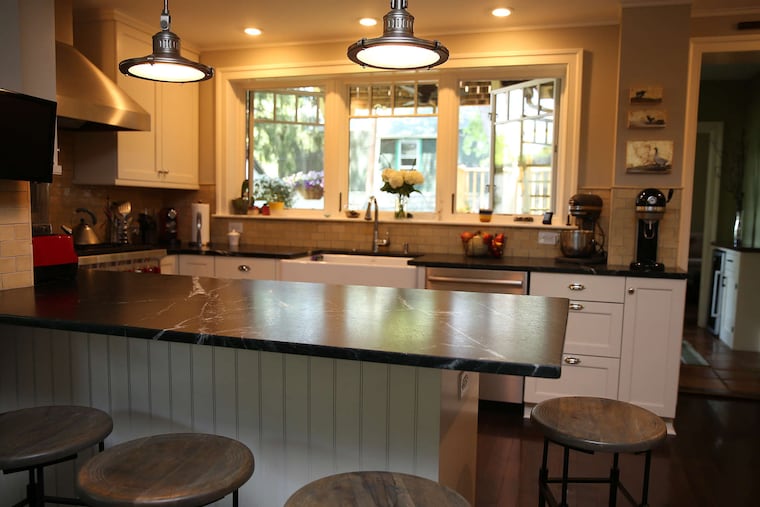Here’s how to pick the best counter for your kitchen
Ready to update your kitchen countertop but unsure which material to pick? Washington, D.C., architect Carmel Greer has some tips for you.

Washington architect Carmel Greer owns the architecture firm District Design and hosts the home improvement podcast On Time, Under Budget, With Love. She has taught design at George Washington University and at the Corcoran School of Art & Design.
Greer joined staff writer Jura Koncius for The Washington Post's Home Front online chat. Here is an edited excerpt.
Q: What’s the best way to select a new kitchen countertop and backsplash that are compatible?
A: One way to guarantee compatibility is to run the countertop material up through the backsplash. There are no seams, and it will look timeless, regardless of your kitchen’s style. Run it all the way to the upper cabinets, which are usually about 18 inches above the counter. If there are no uppers, 18 inches is still a good dimension.
Q: My kitchen has cream cabinets, dark green counters, and cream tile floor. What colors could I repaint the cabinets to make it more modern and luminous without clashing with the bland, sad, cream floor tiles? We might be able to refinish the counters, too.
A: I would avoid white or gray, because that will probably make the older cream tile look very yellow and dingy. If you are in the mood for some fun, I’d paint the cabinets a lighter green than the counter. I would suggest Benjamin Moore’s Spring Break. It’s a vintage color that feels very fresh.
Q: How does soapstone perform for kitchen counters that are used in a family setting? Any suggestions on installation or care?
A: Soapstone is one of my absolute favorite countertop materials. It’s just gorgeous. If you want it to stay a dark, rich color, you’ll need to oil it periodically. Otherwise, it gets lighter over time. (It is not unattractive in its lighter color, but I prefer the oiled look.) Like marble, it can scratch, but you can buff out minor scratches. I always prefer the natural beauty of materials that come from the earth, but there are some quartz products that emulate the look of soapstone. I would unhesitatingly install soapstone for my big, not particularly delicate family.
Q: We had planned on redoing our kitchen in March, and I was thinking of upgrading from laminate to quartz for the counters. I need a no-fuss counter, because I cook a lot. If stainless steel would work and look good, I would consider it. What are the pros and cons? Granite looks dated now, and I was never in love with the granite I saw. Butcher block is too needy. Is laminate coming back?
A: Stainless steel is a tough material, because it scratches extremely easily, and the scratches are very prominent. It’s also expensive to have custom stainless steel counters fabricated, and they feel extremely cold to the touch. Unless you are specifically seeking that kind of commercial restaurant vibe, I’d probably avoid stainless counters. I would not be so fast to write off granite, though. There are honed granites that look very similar to marble and soapstone; not all granites have the dated “speckled” look. Quartz is definitely a good no-fuss option, too. I would not describe laminate as “no-fuss,” because you can scorch it with a hot pot, and there are other ways to damage it, too.
Q: What do you recommend as a cost-saving, stylish and functional way to address the dreaded lower corner cabinet? We have two of them, and one has a lazy Susan that I’m not a big fan of. What other options are out there that we can look at as we plan our renovation?
A: There is a lot of hardware out there beyond the lazy Susan, but I still feel as if corner cabinets are where items go to get lost and forgotten. I try to design kitchens that avoid the corner cabinet by having the runs of cabinets parallel to one another. You might see if there is a way to design your kitchen such that it does not “turn the corner.” If you must have a corner cabinet, I prefer the corner cabinets that are not on a 45-degree diagonal. They just look like regular cabinets but extend into the corner.
Q: I love the clean look of kitchens without upper cabinets, especially with a few open shelves and windows. Will I be sorry if I do this?
A: I love open shelving. When I design a kitchen with a lot of open shelving, I always make sure there is enough closed cabinetry somewhere in the kitchen to hold the unattractive items that we all inevitably own. Tupperware, for instance, will probably not look nice on an open shelf.